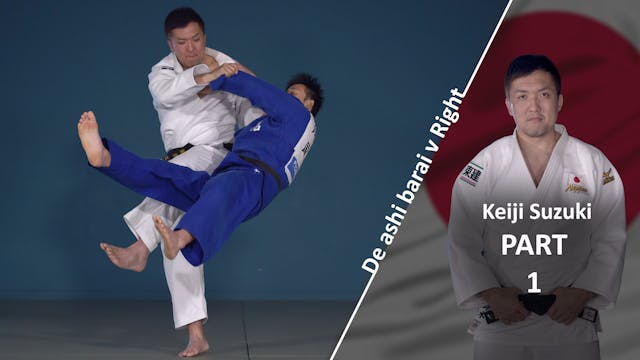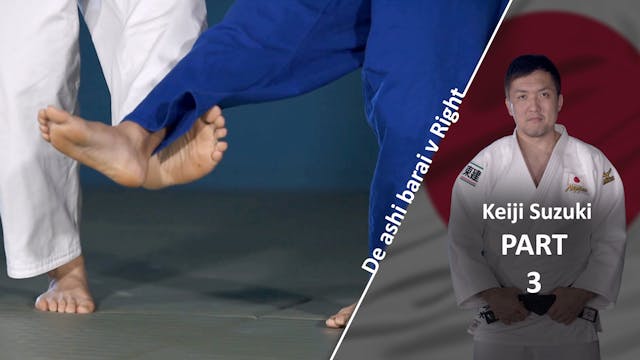The practice of tandoku renshu helps improve timing, an essential component for ashi-waza. As shown here, you must maintain an upright posture and turn the sole of your sweeping foot inwards. This creates the necessary tension in your leg and allows you to comfortably catch the foot you’re attacking. The outside edge of your foot should stay in contact with the tatami for most of the sweep.
When practicing both right and left sides, the corresponding arm is added in a downward arcing motion, replicating the upper-body momentum needed for the technique. As the arm moves across, your hand should rotate inward, as if gripping the opponent’s sleeve. It's important that the arms and legs work together, both in movement and in timing. For practice purposes, you should exaggerate the motion.
Once mastered, the sweeping motion should become shorter and sharper, without sacrificing the quality of the technique. Introducing a side-step movement makes it more applicable to real competition. More focus is needed on timing, with the sweep being performed on every second step. Once you’ve got the hang of it, you can increase the pace and intensity. It is crucial to plant the standing foot firmly on the tatami to provide a strong base and remain balanced throughout.
To develop the exercise further, the direction of movement can be changed. Moving diagonally backward more closely resembles how a sweep is executed in contest. Since judo is unpredictable, it’s important to be able to throw in several different directions. With this backward movement, it becomes increasingly important to focus on the placement of your standing foot, creating a strong opening for the technique.
Here, Kanamaru demonstrates tsubame-gaeshi, an ashi-waza counter. Before each sweep, you swiftly lift your foot, as if evading an opponent’s attack. Then, using your arms, straightening your leg, and turning the sole of your foot inward, you complete the sweep in the same way as the previous exercise.
This can be done as a drill, varying the pace and intensity, and incorporating different movement patterns. Kanamaru notes that it's very common for judoka of all levels to practice ashi-waza using tandoku renshu. However, he observes that it is often done without sufficient intent, effort, or meaning. Some individuals only swing their legs loosely back and forth, without tension or direction.
If done correctly, with the right intention, tandoku renshu is a powerful training tool that can significantly improve the range and effectiveness of your techniques.
Up Next in Watch All
-
Overview VS Right | De Ashi Barai | K...
Double World and Olympic Champion Keiji Suzuki introduces his De ashi barai against right handed opponents.
-
Upper Body VS Right | De Ashi Barai |...
Double World and Olympic Champion Keiji Suzuki reveals the grips and upper body movement for his De ashi barai against right handed opponents.
-
Lower Body VS Right | De Ashi Barai |...
Double World and Olympic Champion Keiji Suzuki reveals the leg movement and foot placement for his De ashi barai against right handed opponents.




3 Comments